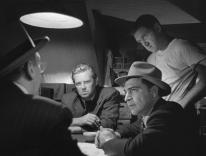
The gentleman approached the bookstore’s salesclerk and asked, “Have you got that new book with my friend, George Smiley?” It was 1979 in Washington, D.C., and Smiley’s People had just been published. Another customer (me) looked up in surprise.
“My friend, George Smiley.” I’m fond of readers who get personally attached to fictional characters, but…a friend of George Smiley’s? That most buttoned-down and least exuberant of secret agents? Then again, the customer looked and sounded as if he belonged to the upper stratum of the Greatest Generation—ramrod straight, immaculately tailored gray suit, clipped WASP diction, sculpted white hair—and since he could have been on a lunch break from the Executive Office Mansion just down the street, I wondered if I was looking at someone who had known or worked with a George Smiley.
And, yes, that sort of reader might very well regard John le Carré’s MI6 hero as a friend. Adroit with a file instead of a gun, pining for his adulterous wife rather than bedding the nearest blonde bombshell, relying on a shrewd assessment of character while leaving karate and poison darts to the Assassin Bureau on the fourth floor, Smiley carried over the Hemingway ethic into paunchy middle age. Ideologically disenchanted (for le Carré the Cold War had no heroes or villains), with no hope of either earthly utopia or eternal rewards, Smiley fulfilled his missions punctiliously because…well, because it was his job, dammit, and because he was good at it. Yes, it was and is possible to feel affection for George Smiley.
Tinker, Tailor, Soldier, Spy, the predecessor to Smiley’s People, was essentially a series of interviews, almost monologues, interspersed with bits of derring-do. Having been dismissed from “the Circus” when a mission backfired, Smiley is later recalled to unearth the mole funneling information to the Russians, and his grilling of current and former agents brings frustrations, longings, and class biases to the surface. When the BBC adapted the novel for television in 1979, director John Irvin’s close-ups turned the story into a showcase for a dozen great portrayals, especially Alec Guinness’s Smiley, perhaps the most seamless performance in the history of British film. That Tinker was a seven-hour congeries of talking heads, and the talk was riveting.
The new feature movie version, directed by Tomas Alfredson, negotiates quite a different route. Working within a time frame of less than two and a half hours, scriptwriters Bridget O’Connor and Peter Straughan abridged the interrogations and diced the narrative into short scenes, including several flashbacks. Alfredson has cleverly telescoped much of the action by showing certain deeds performed in one locale while, on the soundtrack, unseen speakers explain the action. If Irvin and Co. made us feel that we were wending our way slowly but surely through a labyrinth, Alfredson gives the impression that he is assembling a jigsaw puzzle against the clock. That the pieces finally all fall into place is commendable, yet the movie doesn’t satisfy.
The new compression puts the focus on plot instead of characterization, but it was precisely the characterizations that made both novel and teleplay compelling. The movie is all skeleton with just a little psychological flesh on the bones. The supporting cast is well chosen, but few of the actors get a chance to shine. The very short and extremely talented Toby Jones (magnificent as Truman Capote in Infamous) is employed more for his gnomish looks than for his acting. Ciarán Hinds, so compelling in the Irish ghost story The Eclipse, is here reduced to a few shifty sideways glances. Recent Oscar-winner Colin Firth walks through the movie like an overpaid extra, and his character’s climactic monologue, presented by le Carré as the summation of an era’s ideological unease, gets reduced to a couple of sentences. The one exception is Tom Hardy, poignant as Ricki Tarr, an assassin undone by an upsurge of tenderness, but this role benefits from needing little exposition.
The lead presents another problem. Gary Oldman is a tabula-rasa actor. On top of his bland personality, he usually assembles a concoction of make-up, accent, gestures, and some idiosyncratic speech pattern. Sometimes this works well (Harry Potter’s Sirius Black, Lee Harvey Oswald in JFK, parts of his Dracula), but here he creates a Smiley who’s less buttoned-down than mummified. I never felt his affection for his old boss Control (whose destruction Smiley is avenging) or his frustrated love for his wife (who is reduced to the back of some actress’s head) or his pride in his work. Instead, he does some mild gloating, which makes him seem mean-minded rather than dedicated.
Yet much of this film lingers in memory because of its look. Alfredson’s cinematographer, Hoyte Van Hoytema, infuses every shot with an almost subliminal mistiness, through which the characters grope as they try to reach or avoid the truth. Le Carré felt that the Cold War often obscured the truth and befuddled the humanity of its covert warriors, but he never let us forget that their humanity continued to exist beneath the smug smiles and the trade’s catch phrases. Alfredson, skating dexterously through the plot maneuvers, emphasizes mainly the treacheries. The result is a film that moves rapidly, sometimes spasmodically, but always feels dank. His breakout vampire hit, Let the Right One In, benefited from the director’s poker-faced, icy control. But his Tinker, Tailor, Soldier, Spy never lets us in.

Say what you will about Stieg Larsson’s novel The Girl With the Dragon Tattoo, both it and the Swedish made-for-TV movie version of the novel were admirably clear about plot. While watching David Fincher’s new film, I kept wondering if the director and his scriptwriter thought lucidity was unnecessary because Larsson’s many fans would simply fill in the gaps for themselves while they watched.
Steven Zaillian may have been the wrong writer for this project. The author of the Schindler’s List and Moneyball scripts certainly has a heart, as is demonstrated by the way he handles Lisbeth Salander’s seduction of Mikael Blomqvist. (In the novel this is presented as a barely credible act of aggression by a raped woman who would usually find any sexual contact with a man disgusting; Zaillian treats it as an act of compassion toward a wounded man and uses it to signal an emotional breakthrough for Lisbeth.) But “heart” isn’t the most desirable quality for anyone writing for David Fincher, who needs neatly assembled scenarios saturated with perversion, mistrust, and dread, as in Alien 3, Seven, and Zodiac. Even The Social Network, about computer nerd-geniuses, became a sort of serial-killer movie, though the only thing murdered is trust and friendship. Fincher’s world, as I wrote in my review of The Social Network, always has “dank, rainy locales where monsters stalk.” Well, isn’t that the world of Dragon Tattoo? Indeed, but before the morbid violence takes over in the final half-hour, there’s a lot of pedestrian detective work to get through, as computer-genius Salander and journalist Blomqvist solve the mystery of how the daughter of a billionaire industrialist disappeared from an island. Zaillion’s script leaves both the mystery and its solution unclear, and Fincher doesn’t seem even faintly interested in them. When a newspaper clipping or a photo turns out to be a clue, why does the director cut away from it before its importance has a chance to register? If this mystery story is also a portrait of a horrible capitalist clan, why are the clan’s interrelationships rendered so blurrily? And why are their Nazi affiliations during the Second World War so hastily sketched? I’m afraid the answer may be that David Fincher loses interest in a story whenever he’s not using it to put a knot in your guts.
Please email comments to [email protected] and join the conversation on our Facebook page.
Previous Story
New Missal in India
Next Story
Practical Idealism


